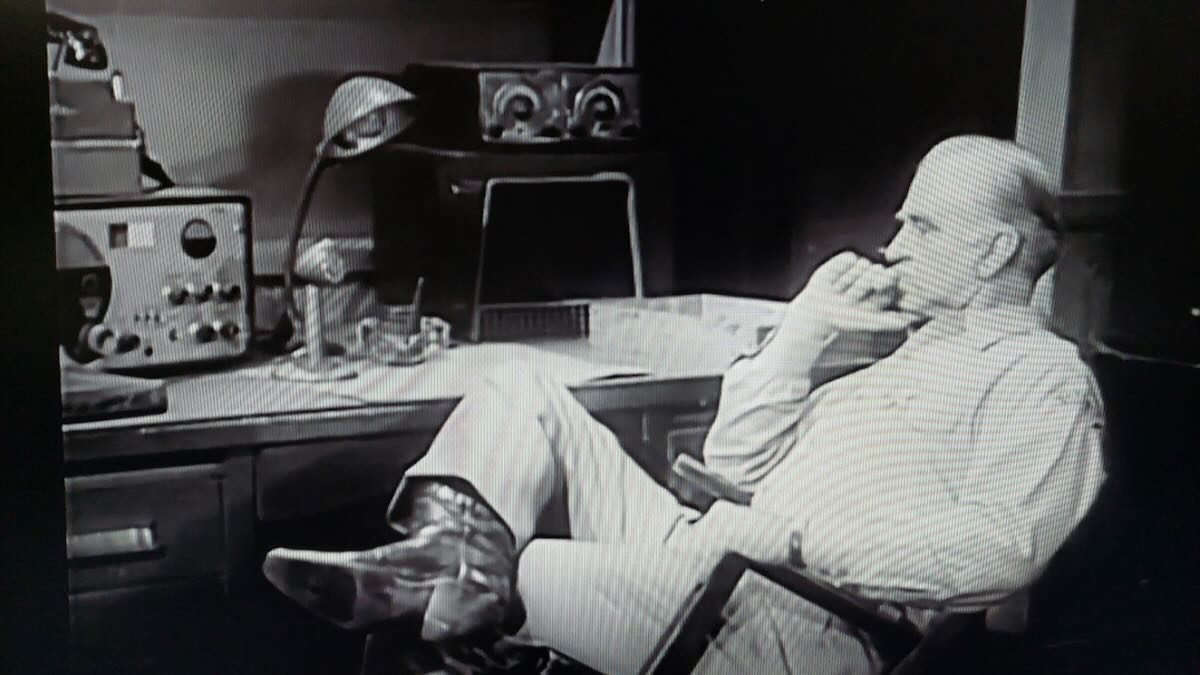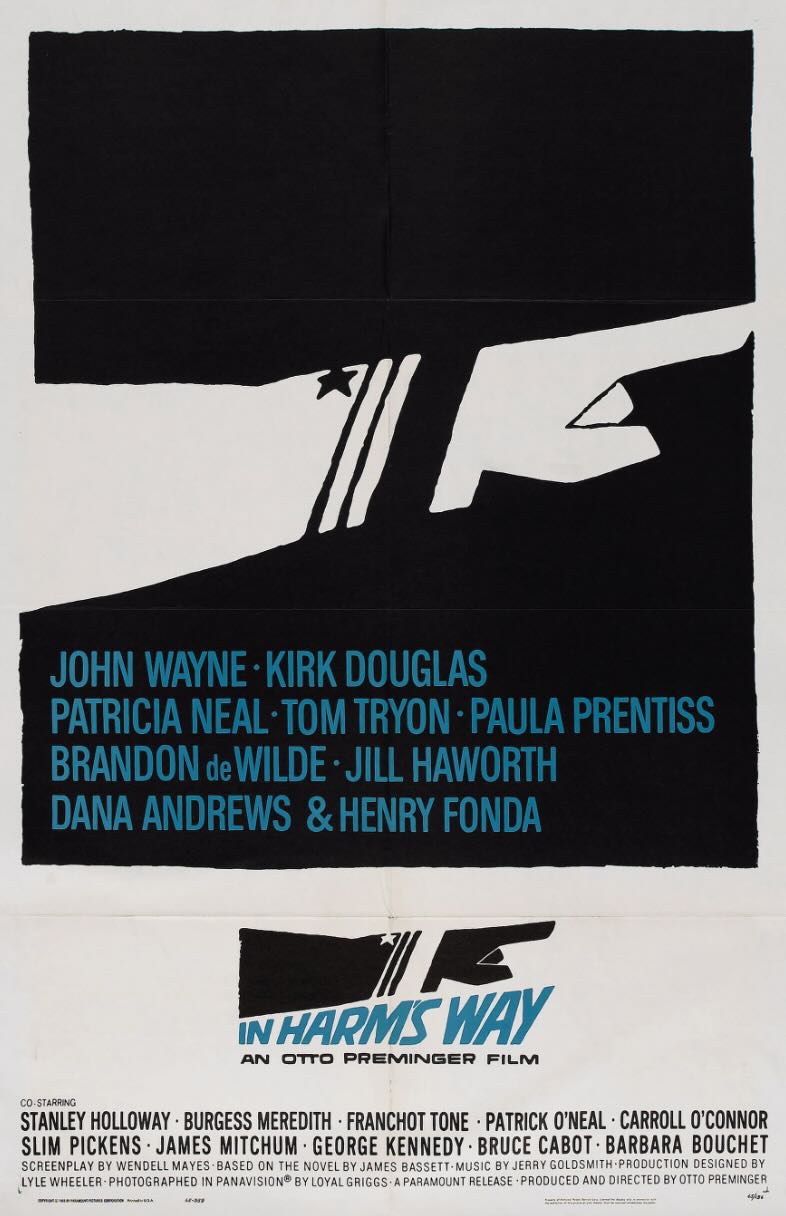 Many thanks to SWLing Post contributor, Dan Robinson, who writes:
Many thanks to SWLing Post contributor, Dan Robinson, who writes:
Who can identify the classic Hallicrafters in the 1960s show Sky King?
Thanks, Dan! Readers: if you know the answer, please comment!

 Many thanks to SWLing Post contributor, Dan Robinson, who writes:
Many thanks to SWLing Post contributor, Dan Robinson, who writes:
Who can identify the classic Hallicrafters in the 1960s show Sky King?
Thanks, Dan! Readers: if you know the answer, please comment!
 Many thanks to SWLing Post contributor, Dan Robinson, who writes:
Many thanks to SWLing Post contributor, Dan Robinson, who writes:
From the 1965 classic In Harm’s Way about the U.S. Navy after the Pearl Harbor attack. In this scene, Patricia Neal is listening to a Tokyo Rose broadcast, and speaking to John Wayne. Neal asks Wayne “why can’t they jam that broadcast?” Can anyone identify the beautiful rig she’s listening to?
Other noteworthy actors in this great movie: Carroll O’Connor, Burgess Meredith, Kirk Douglas, Slim Pickens, Paula Prentiss, Henry Fonda, Larry Hagman, George Kennedy, Christopher George.
Here are two other receivers shown in same movie:
If you can identify the radios above, please comment!
Many thanks to SWLing Post contributor, Frans Goddijn, who writes:
Here’s a little follow up on what I did earlier with the little Hurricane transmitter.
Click here to view on YouTube.
Before I had an ‘indirect’ connection between antenna-OUT of the transmitter and the radio as I had two insulated wires , one from the transmitter, one from the radio, taped close to one another.
Now I first tried a direct coax cable from transmitter-OUT antenna to receiver-IN antenna. That worked well if I took care to not amplify the incoming signal too much.
Next I made a one-off three-way antenna switch into an all-three-way connector.
Then I sent sound/music (by Joe Frank) from the iPhone to the transmitter, to all three radios.
I first listened to each radio and in the end had all three playing the sound.
A pleasant way to listen to some of my favourites!
Best regards,
Frans
I love this, Frans! And what a great music selection to test the new setup! Thank you for sharing, OM.
 Many thanks to SWLing Post contributor, Dan Robinson, who writes:
Many thanks to SWLing Post contributor, Dan Robinson, who writes:
Two of the best foreign shows on Netflix are Wrong Side of the Tracks, produced in Spain, and The Beauty Queen of Jerusalem, from Israel.
Classic antique radios feature in both.
In Beauty Queen of Jerusalem, a wonderful old tube set appears in a scene set in a shop in old Jerusalem (the left of the shopkeeper).
Someone in Spain must be in love with old classic radios because we see a number of them in different scenes — primarily on a shelf in the shop of one of the main characters, along with a few portable radios. The large radio could be Grundig or any one of a number of other European sets — perhaps SWLing experts can provide the answer.
Click images to enlarge:
Can you ID some of these radios? Please comment!
Welcome to the SWLing Post’s Radio Waves, a collection of links to interesting stories making waves in the world of radio. Enjoy!
Many thanks to SWLing Post contributors Dennis Dura, Sten Odenwald, Paul Walker, and David Iurescia for the following tips:
Many thanks to David Iurescia who shares the following announcement (translated from French):
Dear listener,
The French service of Radio Taiwan International is pleased to inform you that during the month of August 2023, we will be broadcasting directly from the Tamsui transmission center in northern Taiwan to Europe and South Africa. north.
In order to better prepare for this radio activity in French, a test broadcast will be carried out on Saturday July 1 on short waves, at the following times and frequencies:
Your listening reports on these 10-minute segment tests will help us identify the two optimal frequencies for August’s “Live from Tamsui” broadcast under the best possible listening conditions.
Thank you for your valued input!
A special QSL card is produced for all the listening reports that you will send us by post, email to the French service or via the stations’s online form, both for the test broadcast and during the August broadcast.
Thank you for listening and for your loyalty.
Cordially,
French Service, RTI
Family members of Japanese nationals abducted by North Korea have recorded encouraging messages for a radio broadcast aimed at the country.
The messages were recorded in Tokyo for Free North Korea Radio, a shortwave broadcaster. Its daily radio program is run by a group of people who defected from the North to South Korea.
The abductees’ relatives called on their loved ones never to give up until they are rescued.
The leader of the relatives’ group, Yokota Takuya, is a younger brother of Yokota Megumi, who was abducted in 1977 at the age of 13. He asked his sister how she is doing. He also said he is sorry that she has had to spend a long time in North Korea without freedom.
He added that the relatives will never give up until they achieve the return of all the abductees.
His twin brother, Yokota Tetsuya, told his sister about their parents. He said that their father, who died three years ago, thought about rescuing his daughter every day.
He added that their 87-year-old mother often falls over, but is doing well. He vowed to get back his sister and asked her to stay healthy until she can be reunited with her mother.
Japanese Prime Minister Kishida Fumio said last month that he wants to start high-level talks under his direct control to hold a summit with North Korea at an early date.
Yokota Takuya said after the recording that he wants the Japanese government to continue its steady diplomatic efforts until all the abductees are returned.
He expressed hope that a Japan-North Korea summit can be held and that North Korean leader Kim Jong Un will decide to hand over all the abductees. [Read the full story and watch the video here…]
Many thanks to SWLing Post contributor, Sten Odenwald, who writes:
Hi Thomas!
Thanks so much for your contribution to the History of Space Weather book I published several years ago!
I have just published a new book I think you might be interested in. It’s called Exploring Space Weather with DIY Magnetometers, and it’s now available at amazon.com (see below). It provides step-by-step designs for building six sensitive instruments for under $60.00 that can measure real-time changes in Earth’s magnetic field.
If you are interested in such a building project, or you know of a family member, teacher, or even a student looking for a science fair project, this book will show you how to build these instruments. I also provide examples of storm events that were actually detected by each design so you can see what typical data looks like. For additional examples and updates, visit my blog page at http://sten.astronomycafe.net/diy-magnetometers/
Thanks again for your help!
Sten Odenwald
Astronomer
Click here to check out this book on Amazon.com (SWLing Post affiliate link).
Many thanks to SWLing Post contributor, Dennis Dura, who notes that a number of vintage and late model radios are up for auction at Schulman’s:
Many thanks to SWLing Post contributor, Paul Walker, who shares the following tip:
It appears they are now operating at US night times now. For the longest time, as you may be aware, they were only on 9275 kHz during the day.
Sometime around mid last week, they were being reported on 15150 kHz as well.
And I finally logged them too.. nice signal on 15150 kHz here just after 0400!!
Please consider supporting us via Patreon or our Coffee Fund!
Your support makes articles like this one possible. Thank you!
Welcome to the SWLing Post’s Radio Waves, a collection of links to interesting stories making waves in the world of radio. Enjoy!
Many thanks to SWLing Post contributors Kim Elliott and Dennis Dura for the following tips:
My most prized possession was once somebody’s trash.
It’s a blocky, black radio that was manufactured in 1941, the year my father was 12 years old. I snatched it from the county landfill when I was 13, in 1978.
The person who threw it away must have determined they couldn’t fix it, though it seemed they thought someone else might. They had set the radio off to the side of the dumpster, safe in plain view, just in case some industrious person with know-how appeared.
That person was my father, who ran an electronics repair business from our garage. Though at first reluctant to save “that ugly old thing,” he seemed pleased hours later when he entered the kitchen announcing that the radio worked fine and had only needed a tube. For years after this, my father kept that radio on a shelf above his workbench, listening to country singers croon about lonesome truckers.
I like to think of myself as a minimalist, but since my father died in 1994, I’ve carried what I consider to be “our” radio thousands of miles from the Appalachian farm where I grew up, out to Los Angeles, and then many years later back home again. In California, I’d tune our radio to horse races being transmitted from Santa Anita or Hollywood Park while cleaning my kitchen. Or I listened to Paul Harvey, Casey Kasem or evangelists spouting “truths” about Jesus and cars. [Continue reading…]
New analysis of AM reach provides market-level insight to listening habits
Following up its recent report on the 141 local markets where at least 20% of the market listens to AM radio, Nielsen has released a deeper look with new data at the state- and DMA-level.
Pierre Bouvard, chief insights officer of the Cumulus Media / Westwood One Audio Active Group, recently posted an analysis of the findings. The data comes from the Fall 2022 survey, but is based on all U.S. radio stations, not just Nielsen subscribers.
Nationwide, 30.9% of radio reach comes from AM stations, representing 82,346,8000 American radio listeners aged 12+ who listen to AM every month. At the state level it ranged from a high of 52.7% in North Dakota to a low of 4.6% in the District of Columbia. In 29 states, the percent of radio reach via AM is greater than 20%. [Continue reading…]
Auto group also says it would take two decades for fleet to turn over and AM to phase out
“Whether or not AM radio is physically installed in vehicles in the future has no bearing on the multiple methods of delivering those emergency communications alerts to the public.”
So writes the president and CEO of the Alliance for Automotive Innovation. John Bozzella used a blog post this past week to summarize the auto industry’s case against a mandate to include AM radio in cars.
It’s simply not necessary, he wrote; and government shouldn’t be propping up a particular technology that’s competing with other communications options, either.
“It’s tempting to take a cheap shot at misplaced government priorities and unnecessary mandates or make light of the whole thing with a jab about laws for hand-crank windows or cassette players,” he writes, calling the legislation a bipartisan solution searching for a problem. [Continue reading…]
Please consider supporting us via Patreon or our Coffee Fund!
Your support makes articles like this one possible. Thank you!
 Many thanks to SWLing Post contributor, Dan Robinson, who writes:
Many thanks to SWLing Post contributor, Dan Robinson, who writes:
Not a false alarm this time — one of the most striking appearances of a classic shortwave receiver was in Battle of the Bulge, the 1960’s movie about the great battle between German and U.S. forces during World War II, lasting five weeks between the end of 1944 and beginning of 1945. This movie had some of the biggest stars of the time, including Henry Fonda, Robert Ryan, Telly Savalas, and Charles Bronson. Robert Shaw played the German commander of the offensive in the Ardennes and scenes in his command trailer showed a beautiful Hallicrafters SX-28/A which audiences are led to believe was both a transmitter and a receiver.
In this scene, the radio is shown as Shaw is chewed out by his superior in the trailer for not making more progress on the battlefield.
The SX-28 is one of the most amazing radios Hallicrafters made. Thanks for sharing this, Dan!